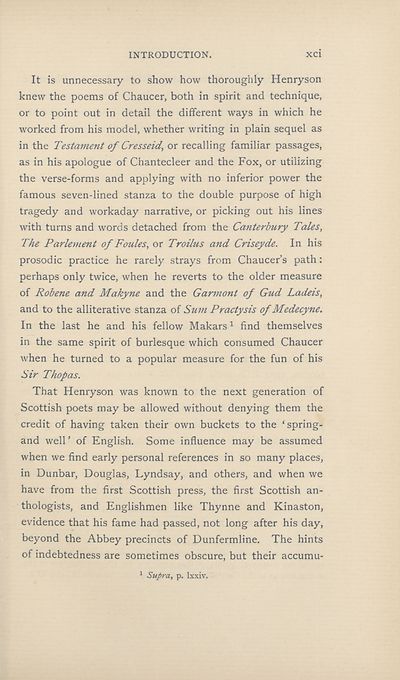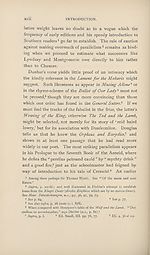Download files
Complete book:
Individual page:
Thumbnail gallery: Grid view | List view

INTRODUCTION.
XC1
It is unnecessary to show how thoroughly Henryson
knew the poems of Chaucer, both in spirit and technique,
or to point out in detail the different ways in which he
worked from his model, whether writing in plain sequel as
in the Testament of Cresseid, or recalling familiar passages,
as in his apologue of Chantecleer and the Fox, or utilizing
the verse-forms and applying with no inferior power the
famous seven-lined stanza to the double purpose of high
tragedy and workaday narrative, or picking out his lines
with turns and words detached from the Canterbury Tales,
The Parlement of Foules, or Troilus and Criseyde. In his
prosodic practice he rarely strays from Chaucer’s path:
perhaps only twice, when he reverts to the older measure
of Robene and Makyne and the Garment of Gud Ladeis,
and to the alliterative stanza of Sum Practysis of Medecyne.
In the last he and his fellow Makars1 find themselves
in the same spirit of burlesque which consumed Chaucer
when he turned to a popular measure for the fun of his
Sir Thop as.
That Henryson was known to the next generation of
Scottish poets may be allowed without denying them the
credit of having taken their own buckets to the ‘spring-
and well’ of English. Some influence may be assumed
when we find early personal references in so many places,
in Dunbar, Douglas, Lyndsay, and others, and when we
have from the first Scottish press, the first Scottish an¬
thologists, and Englishmen like Thynne and Kinaston,
evidence that his fame had passed, not long after his day,
beyond the Abbey precincts of Dunfermline. The hints
of indebtedness are sometimes obscure, but their accumu-
1 Supra, p. Ixxiv.
XC1
It is unnecessary to show how thoroughly Henryson
knew the poems of Chaucer, both in spirit and technique,
or to point out in detail the different ways in which he
worked from his model, whether writing in plain sequel as
in the Testament of Cresseid, or recalling familiar passages,
as in his apologue of Chantecleer and the Fox, or utilizing
the verse-forms and applying with no inferior power the
famous seven-lined stanza to the double purpose of high
tragedy and workaday narrative, or picking out his lines
with turns and words detached from the Canterbury Tales,
The Parlement of Foules, or Troilus and Criseyde. In his
prosodic practice he rarely strays from Chaucer’s path:
perhaps only twice, when he reverts to the older measure
of Robene and Makyne and the Garment of Gud Ladeis,
and to the alliterative stanza of Sum Practysis of Medecyne.
In the last he and his fellow Makars1 find themselves
in the same spirit of burlesque which consumed Chaucer
when he turned to a popular measure for the fun of his
Sir Thop as.
That Henryson was known to the next generation of
Scottish poets may be allowed without denying them the
credit of having taken their own buckets to the ‘spring-
and well’ of English. Some influence may be assumed
when we find early personal references in so many places,
in Dunbar, Douglas, Lyndsay, and others, and when we
have from the first Scottish press, the first Scottish an¬
thologists, and Englishmen like Thynne and Kinaston,
evidence that his fame had passed, not long after his day,
beyond the Abbey precincts of Dunfermline. The hints
of indebtedness are sometimes obscure, but their accumu-
1 Supra, p. Ixxiv.
Set display mode to: Large image | Zoom image | Transcription
Images and transcriptions on this page, including medium image downloads, may be used under the Creative Commons Attribution 4.0 International Licence unless otherwise stated. ![]()
| Publications by Scottish clubs > Scottish Text Society publications > Old series > Poems of Robert Henryson > Volume 1, 1914 > (101) |
|---|
| Permanent URL | https://digital.nls.uk/107411387 |
|---|
| Shelfmark | SCS.STES1.64 |
|---|---|
| Attribution and copyright: |
|
| Description | Edited by G. Gregory Smith. |
|---|---|
| Shelfmark | SCS.STES1.64 and SCS.STES1.55 |
| Additional NLS resources: | |
| Description | A collection of over 100 Scottish texts dating from around 1400 to 1700. Most titles are in Scots, and include editions of poetry, drama, and prose by major Scottish writers such as John Barbour, William Dunbar, Gavin Douglas, and George Buchanan. Edited by a key scholarly publisher of Scotland's literary history, and published from the late 19th century onwards by the Scottish Text Society. Available here are STS series 1-3. |
|---|

